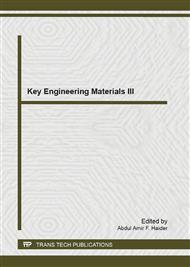[1]
J.M. Leslie, D. Mircea, R.L. Jeffrey, Chem. Soc. Rev., 38 (2009), 1294–1314.
Google Scholar
[2]
M.K. Thomas, Catalysis today 20 (2007), 389 -398.
Google Scholar
[3]
M. A. Salam, Y. Lwin, S. Suriati, Adv. Mat. Res. 626 (2013), 173-177
Google Scholar
[4]
M.A. Salam, S. Suriati Y. Lwin, J. Phys. Chem. Solids 74 (2013) 558–564
Google Scholar
[5]
F. Bergaya, B.K.G Theng, G. Lagaly, Handbook of Clay Science, Developments in Clay Science. Elsevier, Amsterdam; 2006,1,pp-1224
DOI: 10.1016/s1572-4352(05)01007-x
Google Scholar
[6]
Z. M. Ni, W. H. Yu, S. F. Zhao, H. G. Zhong, Chin. Chem Lett. 15(8), (2004), 989-992.
Google Scholar
[7]
L. Zhao, X. Li, X. Quan, G. Chen, Env. Sci. tech. 45 (2011), 5373-5379
Google Scholar
[8]
A. Zuttel, C. Nutzenadel, P. Sudan, P. Mauron, C. Emmenegger, S. Rentsch, Journal of Alloys and Comp. 330–332 (2002), 676–682
Google Scholar
[9]
M.G. Nijkamp, J.E.M.J Raaymakers, A.J. Dillen, K.P. Jong, Appl. Phys. A 72 (2001), 619–623
Google Scholar
[10]
S.H. Jhi, Y.K. Kwon, K. Bradley, J.C.P Gabriel, Solid state communication 129 (2004),769-773
Google Scholar
[11]
J. Z. Larese, T. Arnold, L . Frazier, R.J. Hinde, A.J. Ramirez-Cuesta PRL 101 (2008) 165302
Google Scholar
[12]
E. N. Logunova, A. Ya. Chernyak, Chem. Petro.Eng.43, (2007), 197-201
Google Scholar
[13]
C.C. Rodrigues, M. J. Deovaldo, S.W. Nobrega, M. G. Barboza Bioresource Technology 98 (2007), 886-891
Google Scholar
[14]
X.Z. Li, Quantitative analysis of polycrystalline electron diffraction patterns, Microanalysis and Microscopy 2007.
Google Scholar
[15]
K. Tanaka,Y. Kanda, M. Furuhashi, K. Saito, K. Kuroda, H. Saka, J Alloys Comp. 293 (1999), 521
Google Scholar
[16]
G.Grevillot, S.Marsteau, C. Vallieres,J. Occup.Environ.Hygiene 8,(2011), 279-288
Google Scholar
[17]
J.T. Kloprogge, R.L. Frost, J solid state chem. 146 (1999), 506C
Google Scholar
[18]
R. J. Sibley , R. A. Alberty, Physical Chemistry. 3rd Ed. Wiley.Newyork, 2001.
Google Scholar
[19]
Y. Lwin, F. Abdullah , J Therm Anal Calorim 97(2009), 885-889.
Google Scholar
[20]
S. K. Bhatia, A. L Myers, Langmuir, 22 (2006),1688-1700.
Google Scholar
[21]
C. P. Baldé, Hereijgers, B. P. C. Bitter, K. P. Jong, Angew. Chem. Int. Ed. 45 (2006), 3501-3503.
DOI: 10.1002/anie.200504202
Google Scholar
[22]
M. Dincǎ, J. R. Long, J. Am. Chem. Soc.,129 (36), (2007) 11172–11176
Google Scholar


